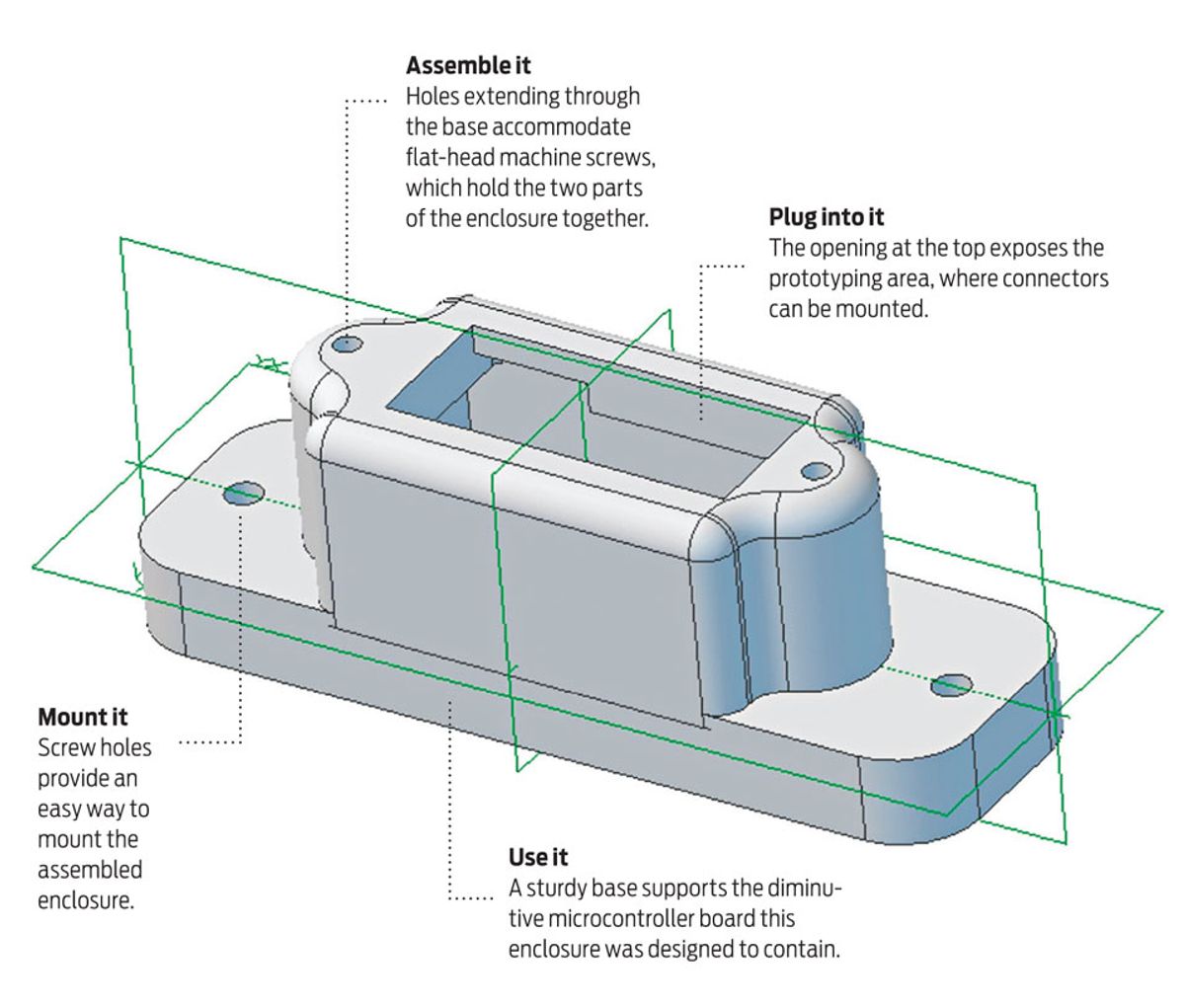Most IEEE Spectrum readers are well aware of the declining cost of 3-D printers. Still, if you don't have the scratch for a US $15 000 desktop unit or the time to build yourself a RepRap, as Paul Wallich described in our January 2009 issue, you'll probably find owning your own unit out of the question. But as Wallich suggested in these pages in September 2010, there's a third avenue to 3-D printing that's easier and probably better: Shop out the work.
Those words may be anathema to hard-core do-it-yourselfers. To be sure, your fingernails will stay embarrassingly clean—the only tools you'll be picking up are calipers and some computer-aided design (CAD) software—but turning an idea into a physical object this way still involves some hands-on moxie, as I've recently discovered.
The abstract interest I had in 3-D printing became quite concrete when I needed an enclosure for a microcontroller. The one I was using—an Arduino Pro Mini from Sparkfun Electronics—is tiny and lacks screw holes, so there was no built-in way to mount it.
To start, I needed to acquire a serious 3-D CAD package. My first choice would have been SolidWorks—the software of choice for many mechanical engineers. But (ouch) licenses start at about $4000. While I'm sure the program is duly impressive, it's overkill for an occasional user like me. Lots of CAD software is available free for the downloading, but the ones I've tested proved far too crude for a project like this. So at a friend's suggestion, I acquired what appears to be the perfect Goldilocks solution: Alibre Design Personal Edition, which is plenty powerful enough for my needs without inducing sticker shock. It costs just $99.
It took me some time to get comfortable with the user interface, because rather than specifying the dimensions when you first draw something, you instead create only a very approximate shape. Then you add dimensions or constraints, at which point the program changes the shape to match whatever specs you set.
It also took me a while (and a visit to Alibre's online forum) to discover the real key to using the software—literally: the F5 key. Hitting F5 regenerates the object on screen with whatever changes you've lately made to its specifications.
Because the Arduino Pro Mini is so small, I decided to mate it with Sparkfun's matching prototyping board, which fits within the same tiny footprint. This would give me a place to mount connectors to the microcontroller, along with a few discrete components if need be. The prototyping board sits directly above the microcontroller, so the whole package remains quite compact.
I designed the two-piece enclosure to have mounting tabs on the base, so it can easily be attached to any surface with a couple of screws. The base supports the Arduino board and includes space so that you can solder wires on without wrecking the fit. The enclosure is open at the top, allowing you to mount connectors to the prototyping board. This part of the enclosure also provides a feature I wouldn't know how to fabricate any way other than with 3-D printing: an inner support for the cantilevered prototyping board.
Following the carpenter's motto—measure twice, cut once—I went over the design carefully to check the interior dimensions against the physical boards before using Alibre's software to generate STL (stereolithography) files, the standard format used to specify 3-D objects for printing. A little probing on the Web revealed the great variety of processes that can be used for this, including fused-deposition modeling, selective laser sintering, and stereolithography. More online investigation with some of the vendors also revealed the great variety in cost. The quotes I received for fabricating my little enclosure ranged from $30 to $150.
Figuring that my first attempt would surely have flaws, I simply chose the fabricator with the best pricing, a company called FastProtos.com, located in Edmond, Okla., which uses a process called PolyJet printing. If the end product was of poor quality, I reasoned, at least I could test it out a bit before my next iteration with some other vendor or process.
The online transaction with FastProtos went as smoothly as buying a book from Amazon, and the enclosure came about as quickly—one week. I was wowed. The curved surfaces showed no awkward faceting, the base and top fit together snugly, and both were very clean, which I understand can't be taken for granted in 3-D printing. Even more surprising was that I hadn't flubbed the design: The stacked printed-circuit boards slipped right in with no discernible slop. So I ended up with a very slick enclosure right off the bat.
Was it worth $30? Ironically, it's the professional result itself that gives me pause—I'm tempted to compare it with the zillions of plastic doodads I buy off the shelf, in which case $30 seems rather steep for so small an item. But were I to be shown something of the same size and shape machined out of a chunk of nylon or Delrin, I would immediately declare $30 to be a great bargain. In any event, there's no question that fabricating highly engineered widgets is nowadays easy and cheap enough to be within anyone's grasp.

